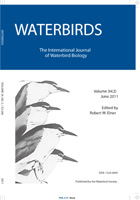Thousands of Black Brant (Branta bernicla nigricans) migrate annually to the Teshekpuk Lake Special Area (TLSA), Alaska, to undergo the flightless wing molt on tundra lakes and wetlands. GPS transmitters were attached to Brant over two summers (2007–2008) to examine patterns of movement and habitat use of molting Brant, including variation by habitat type, year and body mass. Molting Brant were located an average of 31 ± 1 m (SE) from shore and this distance did not vary across any of the explanatory variables. Brant moved an average of 123 ± 3 m hr-1 while flightless. Movement rates varied by year, averaging 22 ± 12 m hr-1 faster in 2008, and across habitat types, averaging 22 ± 13 m hr-1 faster in inland versus coastal and estuarine habitats. Two kernel home ranges were estimated: entire home range, which encompassed the complete 95% probability contour, and shoreline home range, which included only shoreline areas used by molting Brant. Entire home range (x bar = 15.1 ± 2.2 km2) was negatively correlated with body mass, suggesting that heavier individuals have more body reserves to contribute to feather growth and thereby require less food and smaller home ranges. Conversely, shoreline home range (x bar = 4.3 ± 0.6 km2) did not vary by body mass, but rather by habitat type, being larger in estuarine habitats. The complex shorelines and numerous deltaic islands of estuarine habitats offer more shoreline per area than either coastal or inland habitats. Brant appear to have limited ability to adjust their home range size or forage further from shore in response to variable food resources across years or habitats, instead altering their movement rate. Given this apparent lack of behavioral flexibility, Brant may be sensitive to development-related disturbances or habitat losses at molt sites in the TLSA.
How to translate text using browser tools
1 June 2011
Fine Scale Movements and Habitat Use of Black Brant During the Flightless Wing Molt in Arctic Alaska
Tyler L. Lewis,
Paul L. Flint,
Dirk V. Derksen,
Joel A. Schmutz
ACCESS THE FULL ARTICLE

Waterbirds
Vol. 34 • No. 2
June 2011
Vol. 34 • No. 2
June 2011
Alaska
Black Brant
Branta bernicla nigricans
flightless molt
habitat use
home range
movement rate




